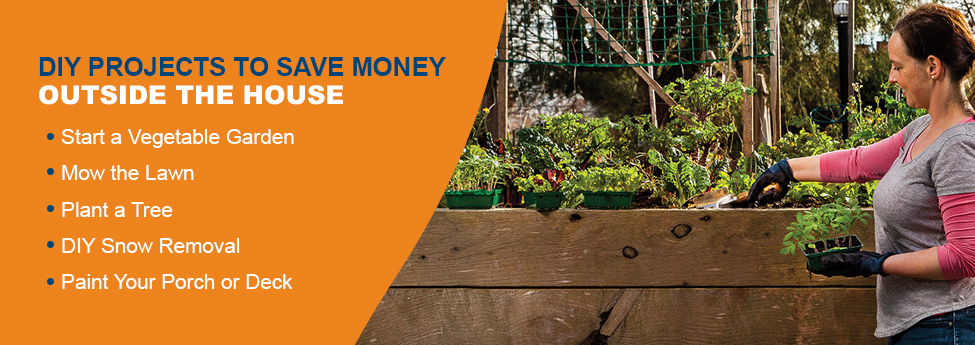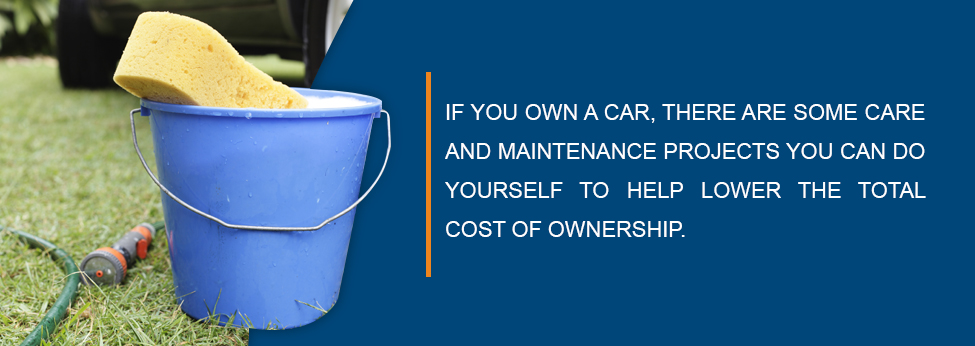17 Simple Home DIY Projects That Will Save You Money

Is it better to DIY a project or to hire someone to do it for you? This is a question homeowners often find themselves asking when they’re preparing to buy a new home or want to renovate their current home. While it’s best to leave some projects to professionals, such as installing new windows or changing the location of your home’s plumbing, plenty of tasks are easy enough to do on your own.
Whether you’ve saved a chunk of money or are looking to leverage your home’s equity, we have a list of ideas for your house. If you want to reduce the costs of homeownership and feel a sense of accomplishment about a job well done, here’s how to save money by doing it yourself.
Home DIY Project Ideas for Inside the House

From the kitchen to the bathroom and from the laundry room to the living room, there are plenty of places where you can save money by taking on simple DIY projects to do at home.
1. Make Your Own Cleaners
The cleaning aisles at many big-box stores feature an array of colorful bottles, all of which promise to take on some tough cleaning jobs and leave your home smelling terrific. Although it’s convenient to buy cleaners, you can stand to save a considerable amount of money if you make your own at home. Plus, when you make your cleaning products yourself, you know exactly what ingredients are in them and don’t have to worry that you’re exposing your family to harsh chemicals.
How much can you save by DIY-ing your cleaning products? It all depends on the product. A citrus-scented kitchen cleaner can cost as little as four cents per ounce to make, while a store-bought version costs approximately 10 cents per ounce, depending on brand, store and location.
There are numerous DIY cleaning product recipes out there. If you’re not sure where to start, purchase some distilled white vinegar, a box of baking soda and some castile soap and you’ll be good to go.
Another thing worth considering if you want to save money: cleaning your home yourself. Nationwide, the average cost of housekeeping services is $167 per session. In Central Pennsylvania, the average price is slightly higher, at around $171. Meanwhile, if you dust, vacuum or otherwise tidy up on your own, all you need to worry about is the cost of your cleaning products.
2. Install a Low-Flow Faucet
The average household spends around $1,000 on water use annually. If you haven’t already done so, replacing your house’s existing faucets, showerheads and toilets with low-flow WaterSense models can help reduce your water bill by around 20 percent.
The complexity of your faucet-replacing project depends on your preference. You can go all out and replace the entire fixture with a more efficient model, which has the EPA’s WaterSense label. A simpler, less expensive option is to replace the aerator at the tip of the faucet with a low-flow model.
3. Install a Ceiling Fan
Installing a ceiling fan in your living room, bedroom or elsewhere in your house can help you save money in a few ways. In the summer, if you use a ceiling fan along with your home’s air conditioning, you can set the thermostat up to four degrees hotter without noticing any difference in comfort. A ceiling fan can also help you keep your house warm in the winter, as long as you reverse the direction the blades spin.
You don’t have to be a DIY superstar to install a ceiling fan. The most important thing to remember if you’re trading a lighting fixture for the fan is that you need to change out the electrical box. Electrical boxes made for lights aren’t strong enough to support the increased weight of a fan.
4. Paint a Room
One simple DIY home improvement project for beginners is to give the walls a new coat of paint. If you hire a professional to paint a room in your home, the cost can be anywhere from $380 to $790. If you DIY, the cost is usually under $300. Multiple factors influence how much it costs to paint a room, from the quality of paint you use to the size of the room. Higher-quality or specialty paint usually costs more but tends to have a longer usage life compared to low-quality paint. Paint is an outstanding way to refresh the interior of your home and make it feel brand-new without having to pay for a whole-room redecoration.
5. Do At-Home Dry Cleaning
Although the best way to save on dry cleaning costs is to buy machine-washable clothing, the occasional “dry-clean-only” garment is sometimes unavoidable. One easy way to cut the cost and hassle of bringing your clothes to the dry cleaner is to purchase an at-home dry cleaning kit.
Home dry cleaning kits let you clean up to five garments at once, using a special bag, a pre-treated cloth and your dryer. The kits also often come with a stain remover and a deodorizer to help you get spots or strong odors out of your clothing.
At-home dry cleaning kits can save you time and money, but remember, they won’t completely replace your dry cleaner. If you’ve spilled something greasy or grimy on your clothing, your best bet is to bring it to a professional cleaner.
6. Install a Water Filter Under the Sink
If you don’t like the taste of your home’s tap water and you’ve been buying bottled water to drink, installing a filter under your sink can help you save money. You’ll save both on the cost of the installation if you DIY and on the expense of bottled water. An under-sink water filter is also a bit more convenient than pitchers with built-in filters, as you don’t need to remember to fill up the pitcher every time you refresh your beverage.
Under-sink water filters vary in price considerably, but you can most likely find an option for less than $100. Filters that use a multi-stage filtering process can cost substantially more.
7. Re-Caulk Your Tub or Shower
Caulk creates a tight seal around your bathtub or shower, reducing water damage. It’s a good idea to occasionally recaulk your tub or shower to keep mold and mildew growth down and to protect the fixtures in your bathroom. Recaulking your tub or shower isn’t an expensive or difficult project.
To do it, you need some supplies, such as painter’s or masking tape, a caulk gun, and caulk designed for use in the bathroom or other wet areas. You’ll also want a knife to cut away the old caulk. When applying the new caulk, place the tip of the caulking gun into the area being sealed and use light pressure to create a thin line of caulk. You can run a finger along the line of caulk once you’re finished to clean it up and give it a neat appearance.
DIY Projects to Save Money Outside the House

DIY projects don’t only take place inside your home. Some exterior projects are easy enough to tackle on your own and can help you save money.
1. Start a Vegetable Garden
Depending on how much outdoor space you have, a vegetable garden in your backyard can produce more than $650 worth of vegetables and fruits. The initial startup cost of a food garden is often less than $250, making it a cheap DIY project for your home that has a high return on investment.
If you’ve never gardened before, it’s a good idea to start small, so you can keep costs low and don’t take on more than you can handle. Plant one or two of your favorite vegetables and see how things go. If you get good yields, you can expand the size of your garden in future years.
2. Mow the Lawn
Lawn care service in Central Pennsylvania costs an average of $225, well above the national average of $136. You can easily save money by mowing the lawn yourself, even if you have to buy a lawnmower. Another way to cut the cost of lawn care is to split the expense of a lawnmower with a few neighbors. You can set up a schedule for sharing the mower and store it in a communal area.
3. Plant a Tree
Planting a tree on your property can help you reduce your cooling costs by up to 35 percent. Depending on the position of the tree, it can protect your home, yard or driveway from the afternoon sun. A tree that provides shade to your central air conditioning unit can also help lower energy costs, as it allows the unit to work more efficiently.
4. DIY Snow Removal
If you’re in good physical health, you can save money by taking on snow and ice removal in the winter, compared to hiring someone else to do it. Shoveling your walkway or the steps up to your porch can also give you a good workout.
Just remember to play it safe when removing snow. Only shovel lightweight, powdery snow and use your legs, not your back, to lift. Take your time while shoveling: It’s OK to take breaks or to stretch, especially if you’re starting to feel tired.
5. Paint Your Porch or Deck
Even if you’re not trying to sell your home, maintaining its curb appeal is essential. One easy way to refresh the exterior of your house is to repaint the porch or restain the deck. Repainting your porch also lets you express the personality of your home by choosing a new color.
It can cost more than $500 to hire someone to stain your deck, including the costs of labor, stain and supplies. Meanwhile, if you DIY, you only have to pay for stain, which often starts at approximately $20 per gallon, and supplies such as brushes and painter’s tape, which can cost around $20 as well.
Easy DIY Projects in the Garage or Driveway

If you own a car, there are some care and maintenance projects you can do yourself to help lower the total cost of ownership.
1. Change Your Car’s Oil
Your car needs oil to run, and that oil needs regular replacing and refilling for best results. Although the old recommendation was to replace your oil every 3,000 miles, newer cars can often go for up to 10,000 miles before needing an oil change.
Your vehicle’s manual will let you know how frequently you need to be changing the oil. It will also let you know what type of oil to buy and what filter you need.
Along with replacing your car’s oil as recommended, it’s also a good idea to check the level every month or so. Checking your car’s oil levels will let you know if there’s a leak or other problem that a mechanic should check out. Spotting any issues early on can help you save money on costly repairs.
2. Check Your Tires
How fuel-efficient your car is and how safe it is to drive depends in large part on the tires. It’s worth keeping your tires inflated to the recommended pressure to help improve its gas mileage. Checking the tires for wear can also let you know if it’s time for a replacement set.
You can evaluate the wear and tear on your tire treads using a penny. Place a penny into the tread of one of the tires on your car, so Lincoln is facing you and is upside down. If you can see the top of his head on the penny over the tread of the tire, the tire has worn down enough to need replacement.
3. Wash Your Car at Home
Taking your car to the car wash can be a way to save time. If you want to save money, though, the best option is to wash your car at home. You can also save money when you wash your car at home by using a hose with an automatic shutoff nozzle that will keep water from flowing out of the hose when you’re not actively using it.
4. Replace Your Windshield Wipers
The windshield wiper blades on your car can wear out over time and usually need replacing at some point. Maintaining your wiper blades is a vital part of keeping your vehicle safe to drive. The blades need to be able to remove snow and rain effectively, and they can’t do that if they get worn down.
You can bring your car to a dealer or auto parts store and have them replace the blades for you, but the project is easy to DIY and will save you the cost of labor. Usually, replacing the blades means sliding the old, worn ones out of the wiper and slipping in the new ones.
It is essential to buy the right wiper blades for your car, but any place that sells replacement blades should have a reference book on hand where you can quickly look up the model number that’s right for your vehicle.
5. Replace Your Battery
Your car battery is likely to need replacing after a few years on the road. Although you can take your vehicle to the dealer for a new battery, it’s an easy enough task to do at home, as long as you follow some basic ground rules.
When disconnecting the battery, take the black, or negative, cable off first, then the red, or positive, cable. Unclamp the battery, then use both hands to lift it out of the car. When connecting the new battery, connect the red cable first, then the black one.

Read Our Blog to Get More Great Ideas for Your Financial Future
What can you do with the money you saved by tackling several home repair and maintenance projects on your own? One option is to open a savings account and let the money you’ve saved earn interest. You can also read our blog to get more great ideas to help you save money and prepare for your financial future.
Share:
Disclosures
The material on this site was created for educational purposes. It is not intended to be and should not be treated as legal, tax, investment, accounting, or other professional advice.
Securities and Insurance Products:
NOT A DEPOSIT | NOT FDIC INSURED | NOT BANK GUARANTEED | NOT INSURED BY ANY FEDERAL GOVERNMENT AGENCY | MAY LOSE VALUE
